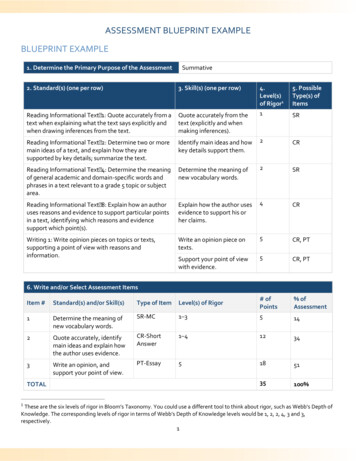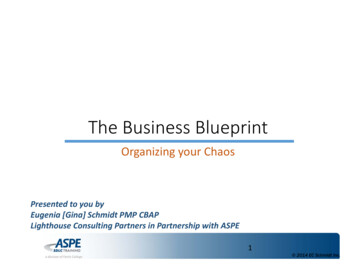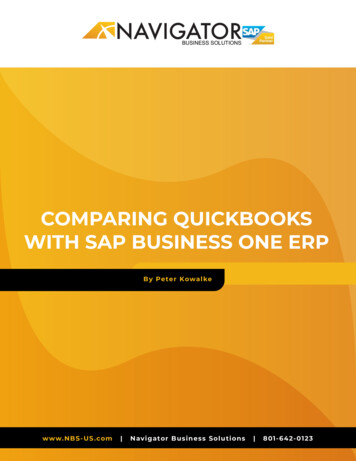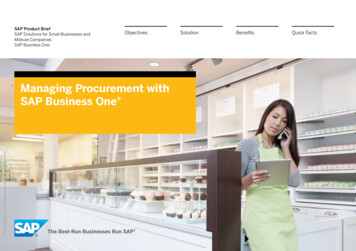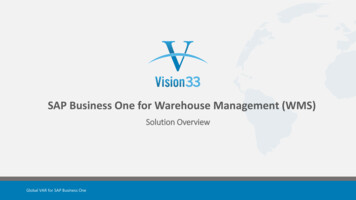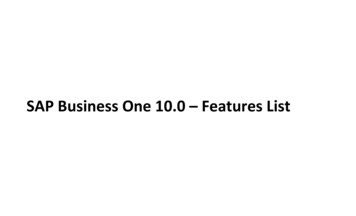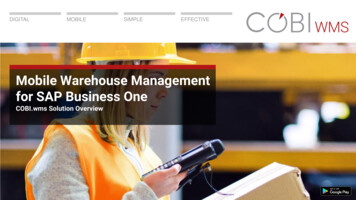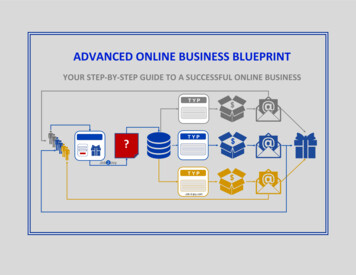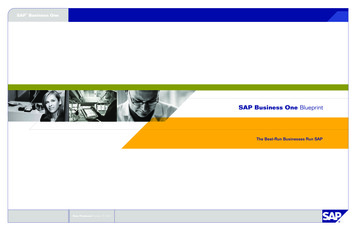
Transcription
SAP Business One BlueprintThe Best-Run Businesses Run SAPDate Produced October 27, 2005
A Fully Integrated Business Management SolutionManaging the Enterprise EcosystemoPhone2pPartnerChannels and TouchpointsSAP Business One offers secure access from anumber of devices and channels across corporateintranets and the Internet, including:· Web browsers· Windows clients for desktop and laptop users· Personal digital assistants (PDAs)· Cellular phones, including those that supportWireless Appliation Protocol ability: You can add or upgrade fields,change forms, and personalize queries and reports—without programming — as the needs of yourbusiness change.psWorkflow-based alerts and key performanceindicators (KPIs): With SAP Business One, youcan manage by exception — monitoring, notifying,and taking action when specific events occur. Anembedded workflow management tool allows youto designate the activities you want to track and totake immediate corrective action when necessary.rWireless3Enterprise Analytics and ReportingSAP Business One provides a 360-degree view of yourbusiness through tight integration of all SAP BusinessOne functional areas. From a dashboard, you can viewhistorical customer interactions, operational logistics,supply chain dynamics, and enterprise-critical analyses.Single Server ArchitectureSAP Business One resides on a single server thatintegrates seamlessly with a standard MicrosoftWindows network. Using a Win 32-based, two-tier,client/server architecture, SAP Business One deliverspeak performance and leverages your existing networkinfrastructure for maximum efficiency.cEmbedded customer relationship management(CRM) functionality: SAP Business One is the onlysolution built for small and midsize businesses thatfeatures built-in CRM. You can manage salesopportunities and conduct sales pipeline analysis,track customer and vendor profiles, maintaincontact information, track account balances, andadminister contracts, and handle service planning. Italso gives you easy views into future sales, as wellas past performance.3SupplierIntegration: SAP Business One synchronizescommunications with seamless integration with theMicrosoft Office suite of products.Drag&Relate : SAP Business One helps youidentify key relationships. Using SAP's patentedDrag&Relate feature, you can select a data field withthe mouse, then drag that field to virtually any menuitem. The resulting instant report displays therelationship of the field to the menu item foron-the-fly, train-of-thought reporting.2WebKey Functions for Your BusinessXL Reporter: This fully integrated reporting andfinancial analysis tool uses a Microsoft Excel-styleinterface and works with Microsoft Excel to provideinstant access to live financial and operational dataresiding in the SAP Business One database.1Roles and DevicesSAP Business One provides access to key businesstouchpoints, activities, and transactions forcustomers, partners, suppliers, and employees.rSAP Business One features user-programmablealerts, workflows, and unique functions for management by exception to create an end-to-end solutionfor complete visibility, tracking, management,control, and analytic reporting of all key enterprisedrivers.1fSAP Business One is a completely integratedbusiness management solution that supports all ofthe key business processes and workflows of smalland midsize businesses. It goes far beyond thetypical stand-alone, disconnected silos ofdepartmental automation to deliver a true,cross-functional system. It is simultaneouslyconnected, concurrently networked, and continuously aware of all interrelated enterprise businessprocesses.cmSAP BUSINESS ONE FEATURESReporting and Data Navigation CapabilitiesUnderlying SAP Technologies (Drag&Relate, Alerts, User Interface Customization)Financials Chart of accounts Account segments Journal entries Journal vouchers Recurrent transactions Exchange rates inmultiple currencies Financial reports Budget cost centers Sales tax calculations Multiple financialperiods Deposits Checks Credits Receipts Deferred paymentsSales Opportunities andpipeline management Contact management Quotations Orders Invoices Deliveries Returns Price lists in multiplecurrencies Client management Gross profitcalculation Microsoft OutlookintegrationService Service contractmanagement Service planning Tracking acrossmultiple customerinteractions Knowledgedatabase Service callmanagementPurchase Purchase orders Purchase deliveries Purchase returns Purchase creditnotes Landed costsInventory Items management Item queries Price lists Receipt to stock Release from stock Stock transactions Warehousetransfers Serial numberstracking Batch management Pick and pack KittingManufacturing Bill of materials Production orders Forecasting Materials resourceplanning wizard RecommendationreportsVisibility, Management, and Control from Prospectto ProfitabilityThink of the SAP Business One architecture as a series ofconcentric workflows, including customer acquisition, throughmanufacturing, delivery, and after-sale service and support.Each of these workflows is fully integrated and aware of thecritical handoffs, activities, and transactions downstream in yourbusiness. In this context, it’s easy to envision how SAPBusiness One provides the necessary connectivity andintegration to manage your entire business — from prospectto profitability.Software developent kitFile Name: 01 US 1027.ai 2005, SAP AG, All rights reservedDocumentContent: SAP Business One OverviewDate Modified: 10/27/2005ControlVersion Number: 3Number200501APRINT ONLYFormatted for US Paper
Rapid Implementation MethodologyRapid ImplementationOperations and RefinementImplementationSAP Business One uses a businss-processoriented methodology for rapid implementation.1Once you establish business rules, deployment isextremely rapid. Typically, businesses are up andrunning in a matter of weeks.2Handoverfrom Evaluation3Analysisand DesignHandover from Evaluation PhaseProcess Analysis and DesignExecution· Describe business processes· Clarify and elaborate on all business· Perform the installation accordingimplementation process. The implementation guide· Develop a time schedule· Define business process needs in detail· Initialize the systemincludes templates that you can use as models. You· Describe the structure of the company· Divide into subjects:· Create databasesAn implementation guide helps you to optimize theprocesses defined in the evaluation phaseand functional requirementsand responsibilitiescan also customize the templates to handle unique· Identify unconventional····· Identify proposed solutions·· Identify activities and the amount of data····· Use the customized demo databaseneeds.business processesThe methodology blueprint (to the right) describesthe complete implementation process, implementation some partial deployments may skip stages.that must be migrated, if possibleTo achieve a smooth and efficient implementation-Kickoff Meetingprocess, use all supporting materials provided with· Present the implementation methodologythis methodology blueprint including:· Review available resources· System initializationSales processPurchasing processInventory managementProduction process and materialsrequirements planning (MRP)Financials and chart of accountsSales opportunitiesServiceBankingReporting· Introduce the SAP Business Onecustomer portalsuper user· Set up all user-defined fields· Compare the data to established reports· Migrate master data· Review results and obtain sign offdata migration and opening balances guide· Searching notes· Creating support messages· SAP support contact informationBefore Going LiveAfter Going Live· Review go-live checklist· System review according to post· Create or import opening balances· Receive raw data for importgo-live checklist· Create custom user manuals· Test the validity of converted data· Perform a month or quarter end closing toreview reporting and system correctness· Obtain sign off for imported dataGo Live· As needed to optimize busines processes:· Implement business process requirements· Create users and authorizations· Create user-defined fields and tables· Create database backup after every majortype and amount of datastep has been completed as needed forinitial operations:· Establish any required integration· Master data migration and opening balancesthat have been defineduser fields that need to be imported· Review data conversion needs, including the· General ledger accounts setup· Individual business process training· Simulate major business processes with a· Prepare data migration steps according to theBusiness One and compare to existinghardwareusers· Simulate all major business processes· Deliver the relevant templates, including therequirements· Mandatory basic navigation training for allpatch was releasedin SAP Business One according to thesystem initialization guidepoints for third-party solutions· Customize the printout templates· Create queries· Create users and authorizations· Create user-defined fields and tables· Review critical success factorsin each section· Create formatted searchesas defined· Customize user-defined printout templates· Create queries as defined· Identify any limitations in the out-of-boxsolution and discuss work-arounds· Create reports· Create alerts· Create formatted searches as defined· Create reports as defined· Explore solution possibilities, includinguser-defined fields, formatted searches,queries, and the use of the softwaredevelopment kit (SDK)Training andSolutionsManagementTraining· Perform any necessary upgrade if a new· Perform system initialization and definitions· Define hardware requirements for SAP5HandoverAcceptance Testing andApprovalto the installation guides· Define authorization and data ownership· Review the time schedule4Installation andCustomization· Define approval procedures inadministration module· Create alerts as defined· Define approval procedures in· Create screen layouts via user settingsadministration module· Define the specifications of possible add-on· Create screen layouts via user settingsdevelopments· Create the project plan and assign tasksrpofSales processgp1rpiHandoverbusiness audit6rr155pp4d3sBankin gSet timeschedulesAnalysis tomer meetingmethods ect taskplanInstallation/Execution13Masterdata migration14Create backups18Createsearch criteria118CreatetemplatesReviewsuccess factors2023Acceptance/Test /ApproveBefore going live2224Go live25Training26After going liveComparedata19Createscreen layoutsccmFile Name: 02 US 1027.ai 2005, SAP AG, All rights reservedDocumentContent: SAP Rapid Implementation MethodologyDate Modified: 10/27/2005ControlVersion Number: 3Number200502APRINT ONLYFormatted for US Paper27Feedback/Refinement
Single Server Architecture and IntegrationA Single Server ArchitectureThe SAP Business One solution resides on a singleserver that integrates seamlessly with a standardMicrosoft Windows network. Server architectureincludes security, backup, and network accessprotocols. Access is granted via wide area network(WAN) terminal services or dial-up networkconnectivity.The SAP Business OneSingle Server API LayersSAP Business One uses standard database backupprocedures, eliminating the need to save and transferthe database to another machine while providingimmediate access to critical business information.SAP Business One is equipped with anapplication programming interface (API) that isbased on Component Object Model (COM)technology, you can use this API to enhancethe functional scope of the solution or adapt itto meet your specific requirements. Developerscan access the COM objects using programming languages, such as Visual Basic, C/C ,and Java.You can use the following databases with SAPBusiness One:Two different APIs are supported: one for thedata interface and one for the user interface.Web browserDashboard analyticsand reportingInternetintegrationServerSAP partnerWeb serverfunctionOperating SystemMicrosoft Windows 2003 ServerStandard/Enterprise 32 Bit(Praxis)Microsoft SQL Server– 1x Intel Pentium IIICPUSybase ASE –1x Intel Pentium IVIBM DB2 Edition –1x Intel Pentium IVRAMMicrosoft SQL Server – 512MBSybase ASE – 1GBIBM DB2 Edition – 1GBHard disk free spaceMicrosoft SQL Server – system partition 0.5GB/data partition 2GBSybase ASE – system partition 0.5GB/data partition 2GB additional 1GB for each companyIBM DB2 Express Edition – system partition0.5GB/data partition 2GBCD ROMDrive 24x or higherDisplay640 x 480 with 256 colors or higherDatabaseMicrosoft SQL Server 2000 SP3Sybase Adaptive Server EnterpriseSmall Business Edition Version 12.5.2 GAIBM DB2 Edition Version 8.1 FP5SoftwareMicrosoft IE 6.0 SP1Microsoft Data Access Components (MDAC)2.6 / 2.8 for Windows 2003 ServerSeamless integrationof third-party or SAPpartner functionalityChannel anddevice integration Microsoft SQL Server Sybase Adaptive Server Enterprise (ASE)—Small Business Edition IBM DB2 Express EditionConfigurationsEase of Use Seamlessly integrated product Search help Drag&Relate Forms QueriesSystem Architecture User-defined fields Two-tier client/server User-defined tablesarchitecture User-defined objects SQL field linkInterface and integration Flat filesMicrosoft OfficeIntegration XML (HTTP, SOAP) Outlook API (COM, .NET, and Java) Excel ODBC WordMicrosoft Windows 2000 Server or Advanced ServerData Interface API1Using the data interface API, developers canextend SAP Business One by adding windows,changing existing windows, and modifying thebehavior of the application to fit uniquebusiness requirements.mySAPBusiness SuiteSAP Business One API LayerWorkstationJavaC VisualBasicC#COMASP.NETData interface APIXMLExternal SystemsIntegration servicesAny otherexternal systemThird-partysoftwareUser Interface APIThe user interface API supplies obj
SAP Business One provides a 360-degree view of your business through tight integration of all SAP Business One functional areas. From a dashboard, you can view historical customer interactions, operational logistics, supply chain dynamics, and enterprise-critical analyses. Managing the Enterprise Ecosystem SAP Business One is a completely integrated business management solution that
